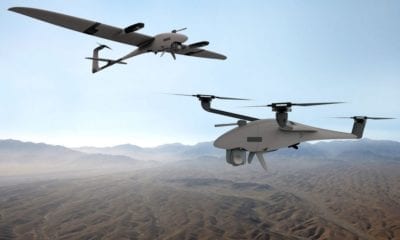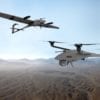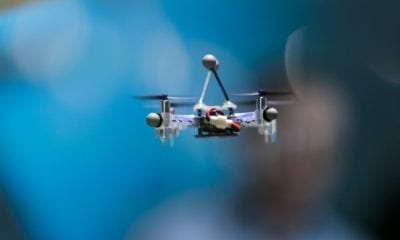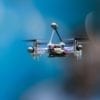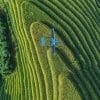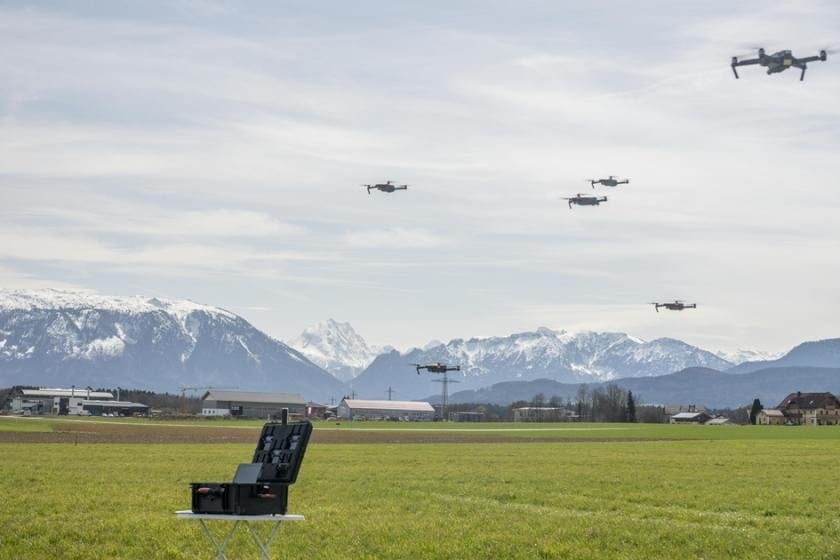
News
Drone Swarm Communication and Control Architectures
Drones or Unmanned Aerial Vehicles (UAV) are one of the most attractive vehicles for a magnitude of commercial uses, mostly because of their ability to bring payloads for utility, sensing and a lot of other uses in the sky without a human pilot on board.
This attractive proposition puts drones at the center of a new paper that focuses on a swarm architecture that will allow for higher levels of swarm autonomy and reliability by utilizing cellular mobile wireless communication infrastructure.
A Part of a New Cellular Mobile Framework
According to the authors, Mitch Campion, Prakash Ranganathan, and Saleh Faruque of the Department of Electrical Engineering at University of North Dakota, drones are part of a new cellular mobile framework that hinders the utility of drone swarms, leveraging a robust and reliable infrastructure for machine to machine (M2M) communication proposed by 5G systems.
As the authors state in the beginning of the paper, a swarm is generally defined as a group of behaving entities that together coordinate to produce a significant or desired result. They state the following:
“The small Unmanned Aerial Vehicle industry (sUAV) has oriented itself mostly as a service industry. The actual sUAV themselves are important, but the real value of the sUAV is the type of payloads they can carry and what type of services they can efficiently provide. Some of these use- cases include photography, cinematography (Canis 2015), precision agriculture (Primicerio et al. 2012), power line and structure inspection (Jones 2005; Morgenthal et al. 2014), surveillance security (Canis 2015), surveying (Chisholm et al. 2013), Infra-red and multispectral imaging (Turner et al. 2010; Previtali et al. 2013; Bendig et al. 2015; Vega et al. 2015), natural disaster recover (Neto et al. 2012), search and rescue operations (Rudol 2008) and many more (Canis 2015).”
The Capability of Swarms is an Intriguing Development – However in its Infancy
The current state of swarm, according to them, is in line with regulation that makes the simultaneous operation of UAVs illegal under many laws. However, the capability of swarms of UAVs is an intriguing development that is only in its infancy – with many limitations to the traditional operation of UAVs mostly seen through their limited payload, limited flight times and remote pilot requirements.
“Advantages to swarm include time-savings, reduction in man-hours, reduction in labor, and a reduction in other associated operational expenses. One specific example of a commercial application that would benefit from UAV swarm is the observation of normalized difference vegetation index (NDVI),” the authors stated. According to them, “NDVI is an important observation for precision agriculture. NDVI observation requires flying sUAS over farmland. Cameras equipped with remote sensing equipment record high resolution geo-tagged imagery of crops. NDVI imagery and sensing equipment show what parts of fields of crops are in the proper or improper stages of development. Surveying a farm with hundreds or thousands of acres is time-consuming and lacks efficiency using current methods. The use of a coordinated number of sUAV surveying an entire farmstead with little to no operator intervention would greatly increase efficiency and could revolutionize precision agriculture.”
The authors study the varying levels of autonomy for autonomous vehicles based on the number of tasks, coordination or decision making that a vehicle can make without input from an operator.
Autonomous Swarm Control (ASC) and an Algorithm that Focuses on Swarm Communication Architectures
They specifically focus on autonomous swarm control (ASC) and all of the phases involved, including the perception phase and the planning phase, both of which are important in this process.
“The UAV swarm environment poses specific challenges, therefore careful selection and development of algorithms are required for its suitability. Specifically, the autonomous control of many UAVs in a safe and efficient scheme is of utmost importance. There are number of proposed methods for swarm control algorithms. Perhaps the most common algorithm proposed for UAV swarm control and planning revolves around variations and adaptions of particle swarm optimization.”
This is the main algorithm that the research is focused on – proposing it and demonstrating it in simulated environments while comparing it to the current swarm communication architectures.
Establishing a Flying Ad-Hoc Network (FANET) and a Proposed Wireless Ad-Hoc Network (WANET)
The authors also focus on establishing a flying ad-hoc network (FANET) architecture in order to coordinate communication between all drones in a network. Here, FANETs are a group of UAVs that communicate with each other with no need to access point – and with at least one of them connected to a ground base or satellite. In contrast to this, they also propose a wireless ad-hoc network (WANET) as one that does not rely on existing architecture to establish the network.
“Direct communication between UAVs forces distributed decision making because it is not a necessity for an infrastructure-based decision engine. This also provides built in redundancy as the entire swarm is not dependent upon an infrastructure to execute the desired operation. This is a primary advantage of FANETs. Some drawbacks to FANETs are related to SWaP considerations.”
Their proposed swarm architecture focuses on high levels of autonomy which can still be achieved despite the distributed nature of the proposed infrastructure-based architecture. In the preliminary development, the UAV swarm technology is seen as one that is driving the development as a test-bed of equipment to test UAV swarm architectures and communication structures.
Final Words
To sum things up, the researchers conclude that their paper provides a solid concept level proposal, showing the initial development and literature review for the use of cellular networks as the communication infrastructure for UAV swarms. It also provides an overview of the sUAS industry, the applications of UAV swarms as well as in-house development efforts for the UAV swarm.
Even though swarm technology has yet to be practically utilized in commercial applications, there is great potential and the use of cellular mobile framework alleviates limiting factors for traditional UAVs swarm communication approaches.
Citation: UAV Swarm Communication and Control Architectures: A Review, Mr. Mitchell Campion, Dr. Prakash Ranganathan, Dr. Saleh Faruque, Journal of Unmanned Vehicle Systems, 0, 0, https://doi.org/10.1139/juvs-2018-0009



